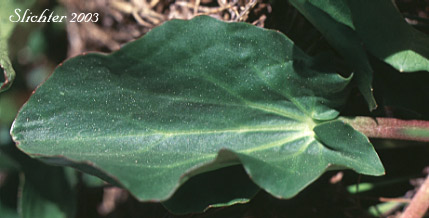 Photo
at right of elkslip marshmarigold as seen along the upper South Loop Rd at the
Steens Mt............June 25, 2000. Note the bluish exterior surface of
the sepals.
Photo
at right of elkslip marshmarigold as seen along the upper South Loop Rd at the
Steens Mt............June 25, 2000. Note the bluish exterior surface of
the sepals.
Elkslip marshmarigold (var. leptosepala) is a low growing, beautiful perennial wildflower of very moist places. It typically has a single flower on the stem and has narrower leaves than its almost identical cousin, Caltha leptosepala var. biflora. The basal leaves are long petioled (the petioles from shorter than to 2-3 times longer than the blades) with a dark green, shiny upper surface. The blades are oblong-ovate in shape and up to 6 cm long and less than two-thirds as wide. The margins range from nearly entire to toothed.
The flowers are actually six to twelve white sepals. The outer surface may be lined with blue, giving a patch of this marshmarigold an icy appearance when in bloom. Petals are lacking. The yellow stamens and greenish pistils are centrally located and both are numerous. Marshmarigolds bloom within weeks of the snow melting. The fruits are many seeded pods.
Elkslip marshmarigold is found in very moist areas, including streambanks, moist meadows, and seeps from montane forests into the alpine zone.
Elkslip marshmarigold is widely distributed in mountainous areas from Alaska south through the Rocky Mts. to Colorado, Utah and possibly Arizona. It is found westward to northeastern Nevada and southeastern Oregon.
 -
- 